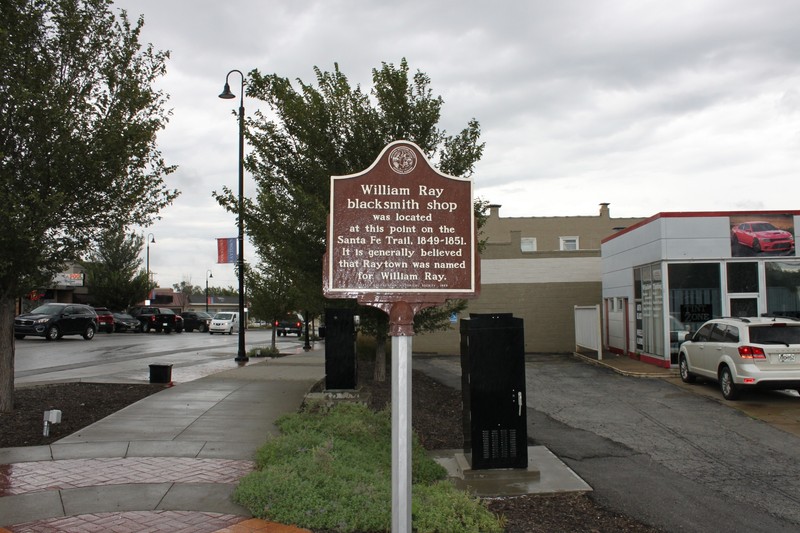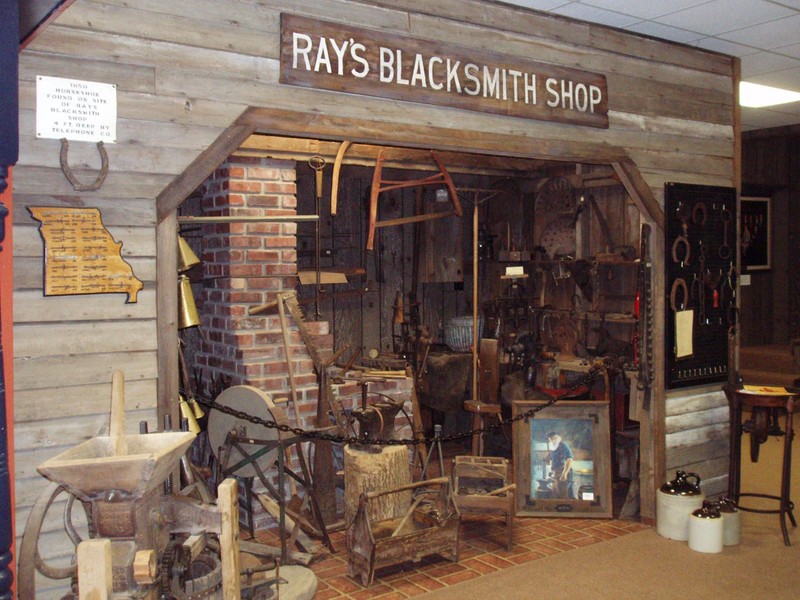Historical Marker: William Ray Blacksmith Shop
Introduction
Text-to-speech Audio
This marker at the intersection of Raytown Road and 63rd Street shares the history of William Ray's Blacksmith shop, which was located here from 1848 to 1851. Ray, the namesake of the city of Raytown, chose this location because it was a stop on the Santa Fe Trail. Many travelers relied on William Ray to fix their wagon wheels and smith the tools necessary to operate a farm or make the long journey to the West. For those who would like to learn more about William Ray and the early history of this Missouri community, the Raytown Historical Society Museum includes a recreation of Ray's Blacksmith Shop.
Images
Historical Marker: William Ray Blacksmith Shop

Ray's Blacksmith Shop display at the Raytown Historical Society Museum

Backstory and Context
Text-to-speech Audio
Once home to the Osage Indians, this area of what is now Raytown was a stop on the Santa Fe Trail. The trail led many to pass by the area, and some of them chose to return to the area or establish farms and businesses in this area rather than travel westward. The town's namesake, William Ray, was born in Butler County, Ohio, in 1808 and moved to Jackson County, Missouri around 1848. Ray purchased seven acres of land and established a Blacksmith shop on the Santa Fe Trail while his son tended to a rented 20- acre farm.
William Ray operated his Blacksmith shop until 1851. In addition to smithing farm tools used by local farmers, Ray routinely repaired wagons used by settlers preparing to travel westward along the trails. Ray's Blacksmith shop also fashioned the accessories necessary to travel on foot 800 miles southwest to Santa Fe or 2,000 miles west to Oregon or California. Ray built and repaired such items as horseshoes, wagon wheels, cookware, and oxen yokes.
Although the Ray family departed the area in 1853 for Oregon, his influence on the town continued throughout the decade. During the 1850s, residents began referring to the community as Ray's Town and eventually Raytown. When the residents sought better roads and access to Kansas City and Independence, Missouri, the town responded by constructing what is now Raytown Road.
William Ray died in Oregon on August 18, 1874, but the marker celebrates his influence on Raytown, as well as the many travelers passing through the town on the way to Santa Fe, California, and Oregon.
Sources
Conrad, Mary. "Re-Enactors of Raytown History." Missouri River Outfitters: Santa Fe Trail Association, (Dec 2011): pg. 2. https://www.santafetrail.org/chapters/mro/MRO_December_2011.pdf.
Fischer, William Jr "William Ray Blacksmith Shop." The Historical Marker Database. HMdb.org. October 9, 2019. https://www.hmdb.org/m.asp?m=69744.
"History." Raytown Chamber of Commerce. raytownchamber.com. Accessed April 20, 2022. https://raytownchamber.com/history/.
"Raytown Historical Society Museum." National Park Service. nps.gov. Accessed April 20, 2022. https://www.nps.gov/places/raytown-historical-society-museum.htm.
William Fischer, Jr. https://www.hmdb.org/m.asp?m=69744
Raytown Historical Society
